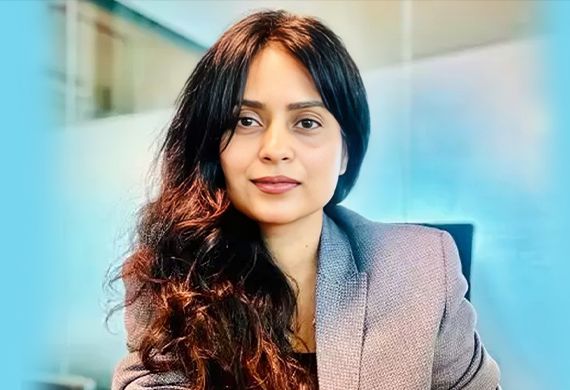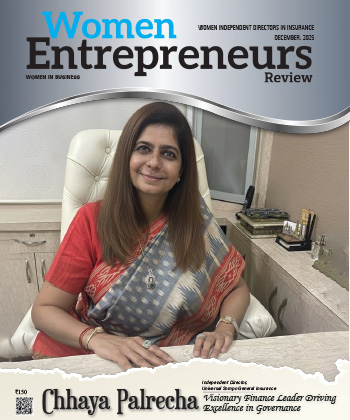
This Woman-led Insuretech Startup is Helping Bridge the Education Financing Gap in India
By: WE Staff
Gunjali Kothare founded FlashAid is an insuretech company that aims to make quality education financially accessible and stress-free for students by offering a loan-free, EMI-based payment solution. In a conversation with team WER, Gunjali talks about FlashAid’s modus operandi and more.
In India’s rapidly growing education sector, financing remains one of the biggest roadblocks for students and families. Traditional lenders often reject applications from self-employed parents, farmers, and small business owners because they don’t fit into outdated credit models or lack formal income documents.
For many families, loans carry a stigma and a heavy psychological burden, leaving them unable to afford higher education or upskilling opportunities. At the same time, educational institutes, despite partnering with multiple lenders, continue to lose up to 30 percent of prospective enrolments because students fail to secure funding.
Determined to break down the financial barriers holding students back, Gunjali Kothare founded FlashAid, a company that takes a contrarian approach to education fee payments without loans. Being a fintech innovator, she reimagined how students and families pay for education with a journey that began far from the startup corridors rooted in education, wellness, and a relentless drive to create impact.
Instead of forcing families to pay large sums upfront or take on debt, the company offers pocket-friendly EMIs backed by insurance. Through its SmartFee model, Flash Aid ensures that families can spread their payments into manageable instalments while educational institutes remain protected against defaults. In case of a crisis like job loss or medical emergencies, the insurance layer kicks in, covering the remaining fees, transforming what was once a burden into a safety net.
By combining EMI flexibility with insurance-backed security, Flash Aid is not just solving a financial challenge but also creating a new category in education financing, making quality education more accessible while de-risking institutions from revenue loss.
Why Students Need Protection beyond Loans
One of the most overlooked gaps in the education financing ecosystem lies in insurance awareness and protection. By the time a student crosses the age of 23, they are often left without any policy coverage unless they join a corporate job that provides it. Freelancers, self-employed individuals, and young professionals outside the formal workforce are particularly vulnerable, with little to no understanding of how insurance works or how to secure a policy. This lack of protection becomes especially critical given the alarming rise in student suicides, accidents, and health-related emergencies. For many families, these risks not only create emotional distress but also disrupt the continuity of education, often forcing students to drop out due to financial instability.
FlashAid steps in by embedding insurance directly into the education payment process. Every student or professional using its SmartFee model is automatically secured, whether they are pursuing higher education or enrolling in an upskilling program. If a crisis occurs, such as death, disability, hospitalization, or even job loss for working professionals, FlashAid ensures that their EMIs are covered. This not only protects families from sudden financial shocks but also guarantees that students can continue their learning journey without interruption.
Gunjali mentions, "I believe that when you show yourself clearly and communicate with honesty, you not only build a brand but also a relationship of trust. That’s what we are doing with FlashAid: making education accessible, affordable, and secure for families across India."
The company’s solution also addresses another pressing challenge: affordability for working professionals seeking to upskill. With limited disposable income after monthly expenses and obligations, paying lump-sum course fees upfront often becomes unfeasible. FlashAid eliminates this barrier by offering simple, loan-free EMIs backed by insurance, requiring minimal documentation. By doing so, it creates a safety net that combines accessibility, flexibility, and protection, making education financing smarter, safer, and more inclusive.
Embedding Insurance Where Gen Z Learns and Spends
In India, the insurance landscape has long been dominated by agents targeting middle-aged customers or by corporate-provided policies for employees. This leaves an entire generation of students and young professionals, especially Gen Z, largely untouched and unaware of the protection insurance can offer. While these digital-native learners are quick to adopt new trends like health supplements, online investments, and fintech apps, they rarely think about financial safety nets. Yet, with demographic shifts such as declining fertility rates and increasing mortality, the need for early insurance adoption is becoming critical.
“FlashAid recognizes this gap and sees embedding insurance into education payments as the most effective way forward. Just as fintech platforms have simplified investing in bonds and mutual funds with one-click access, FlashAid makes insurance-backed education EMIs simple, transparent, and easy to adopt,” says Gunjali.
The company cuts through the fine print and jargon that traditionally make policies confusing and hard to claim. Instead, it leverages clear communication tools, pictorial guides, explainer videos, AI-powered chatbots, and agentic calls to ensure that students and parents understand exactly what they are covered for and how claims can be made. Gunjali adds, "When I started building FlashAid, the biggest realization was that communication is everything. Whether it’s a notification, a reminder, an email, or a WhatsApp bot, the way you communicate with users decides how much they trust you. If you keep it simple, transparent, and accessible, you can prevent most challenges before they even arise."
By building this trust and transparency into the system, FlashAid not only safeguards education continuity but also introduces young learners to the value of insurance in a way that feels accessible and relevant. It transforms what was once seen as a complex, agent-driven product into a seamless, digital-first experience, embedding protection directly into the education journey.
Making the Invisible Students Visible
Gunjali recalls the story of a FlashAid user, a father from Kochi. Despite running a successful business, his low CIBIL score had rendered him invisible in the eyes of traditional lenders. Like countless others, he was locked out of the fintech ecosystem not because he lacked the ability to pay, but because outdated credit models failed to recognize him. Struggling to communicate in Hindi or English, he could say only one thing with clarity: “I want my son to study.”
FlashAid changed that by offering him simple, loan-free EMIs backed by insurance protection. The company ensured his son’s admission and safeguarded his family against future risks.
This story is far from isolated; it represents a systemic problem in India where less than 10 percent of education financing comes from banks and NBFCs, leaving a massive ₹9 lakh crore gap filled directly by parents. Both families and institutions remain unprotected in this model, carrying the risk of dropouts and defaults.
Gunjali is addressing this issue with FlashAid, with more than 200 institutes and 50 universities already onboarded. The company is not just enabling access to education but also de-risking the ecosystem for all stakeholders. By making the “invisible students” visible, FlashAid is proving that financial inclusion in education goes beyond credit; it’s about trust, accessibility, and protection.
Listen, Innovate, and Challenge the Status Quo
Reflecting on her journey into solving a critical challenge, Gunjali shares sound advice for aspiring entrepreneurs. She says, "It’s extremely important to listen to your users. Regulations, servicing hurdles, and legacy systems will always create roadblocks, but innovation starts when you ask the right questions: Why can’t we try this differently? At FlashAid, we took a contrarian bet by asking why students must be tied to loans and CIBIL checks to pay their fees. Instead, we used insurance as a security layer, creating a unique solution fee protection that helps students continue their education without debt while de-risking institutions."
If India wants to unlock its true potential and grow into a stronger, education-driven economy, it is critical to support students with smarter, more inclusive financing solutions. The future of India’s GDP depends on them. Fintech and insurtech players must lead this change by constantly innovating and reimagining what’s possible.
Most Viewed
- 1 Women's Health Startup HerMD Closing Doors Amid Industry Challenges
- 2 5 Famous Women in Indian Armed Forces
- 3 Saudi Women No longer Require Male Permission for Clothing Choices, says Prince MbS
- 4 Kolkata Medtech Startup Innovodigm Raises Rs 5.5 Crore Seed Funding Led by IAN Group
- 5 Yamunanagar's Kashish Kalra Honoured after Securing 111th Rank in UPSC Civil Services Exam
- 6 Madurai Appoints Its First Woman Corporation Head
- 7 IAS Vijayalakshmi Bidari Appointed as the new Nagpur Divisional Commissioner
- 8 American Entrepreneur Lucy Guo Overtakes T Swift to become Youngest Female Billionaire
- 9 ICC Women's World Cup 2025 Trophy Showcased at Indore's Holkar Stadium
- 10 Aparna Saxena's Beauty Venture AntiNorm Launches in India
- 11 Vidya Nataraj Co-Founded BlueStone Jewellery & Lifestyle files IPO
- 12 5 Women Freedom Fighters of India
- 13 Dr. G Krishnapriya appointed as CEO for Trichy
- 14 M3M & Sirona Partner to Introduce Menstrual Hygiene Vending Machines in 15 Locations
- 15 Punjab Govt launches SHE Cohort 3.0 Supporting Tech-led Women Startups
- 16 Indian origin Lawyer, Sweena Pannu appointed as the US New Superior Court Judge
- 17 The Aurora Tech Award recognizes 4 Indian Women-led Startups
- 18 Kerala's Republic Day parade featured an all-female tableau
- 19 Manisha Kabbur Becomes Karnataka's First Woman International Karate Coach
- 20 Director K. S. Ravikumar's Daughter Maalica Ravikumar Launches Life Coaching Company 'Evergrowth Academy' for Women
- 21 Leezu's Raises Pre-Seed Funding to Accelerate Growth in Sexual Wellness Industry
- 22 Sattu: Super-easy summer drink for PCOS gut healing
- 23 Swathi Nelabhatla creates Sitha App, India's First Women-Exclusive Gig Platform
- 24 7 Timeless Female Kathak Dancers & their Iconic Legacies
- 25 Meet 7 Iconic Women Architects of Modern India & their Most Impactful Work
- 26 This Woman-led Insuretech Startup is Helping Bridge the Education Financing Gap in India
- 27 Women Leaders Share Lessons Learnt from India Women's WC Win
- 28 5 Enterprising Women Founders Powering Singapore's Tech & Innovation Landscape
- 29 4 Women. 4 Stories. One Vision for Smarter, Stronger Healthcare
- 30 Global Gender Gap Narrows to 68.8%, But Full Equality 123 Years Away: WEF Report 2025
- 31 Changemakers: 7 Women Entrepreneurs Taking the Make in India Movement Forward
- 32 Meet Lucy Guo, The Youngest Self-Made Female Billionaire Disrupting Tech
- 33 How Women are Driving India's Festive Online Shopping Surge





